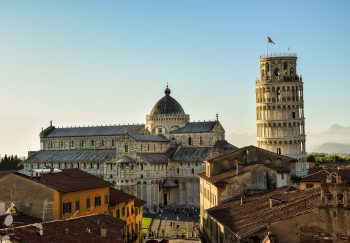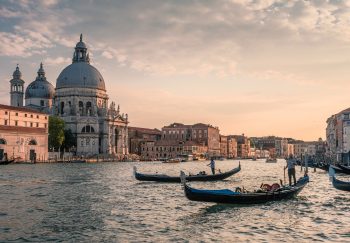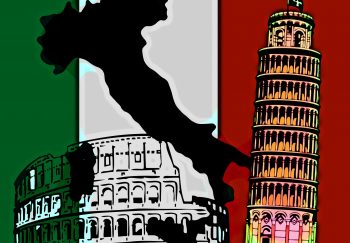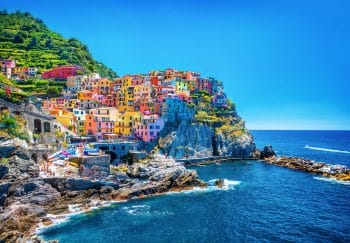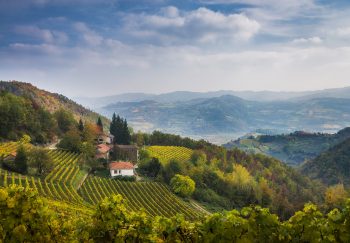2015 saw the designation of the Arab-Norman Palermo, the Cathedral Churches in Cefalu, and Monreale as UNESCO World Heritage Sites.
Here’s the complete list of monuments in the Arab-Norman Circuit, UNESCO World Heritage Site 2015.
Royal Palace – Palazzo Reale
It is possible that both Romans and Phoenicians built fortresses to control the entire area of the city on the hill where the palace stands today. These early buildings are gone. After having constructed a castle for themselves they abandoned it because the Emir wanted to take all his officers and soldiers to Al-Halisah, the coastal region.
Through restoration and transformation, the Normans made the building a magnificent Palace. It was home to the large Aula Regia (also known as Aula Verde), where the king held meetings and hosted banquets. Apartments, toilets, and staff quarters were situated in separate wings connected by balconies, terraces, and gardens rich with green and water basins that had an Arabian flair.
The palace is the most significant example of western Fatimid Palatial Art from a stylistic perspective. It has the best architectural features and the finest decorations. The palace suffered a decline after Frederick II’s death in 1250. It was abandoned for three centuries until the Spanish viceroys made it their home. They saved the building, but also modified its appearance to their liking. The building still houses at least two exceptional Arab-Norman jewels: the Sala di Ruggero and the Palatine Chapel.
The Sala di Ruggero used to be a bedroom. It has a panoramic view of Palermo’s Bay. Elegant mosaics depicting hunting scenes with stylized plants and figures are beautifully incorporated into the walls. This is a rare example of secular mosaic art from that era, with its roots deep in North Africa and the Persian East.
Palatine Chapel
It was inaugurated in 1130, which is the year of Ruggero II’s coronation, the first king from Sicily. According to an inscription on the dome, it was completed in 13 years. It was then dedicated in 1143. This church, described by Maupassant to be “the finest religious jewel ever imagined by the human mind”, allows us to experience the fusion between contrasting cultures and styles, proving that Sicily has always been a meeting place for various ethnic groups, including Arabs, Byzantine, and Northern Europeans.
The chapel has three naves, divided by granite columns and richly gilded Corinthian capitals. It is shaped as a Western Basilica. The chapel is designed in a Western style, but with Southern influences, such as the decorated floors, inlays on the steps and balustrades, and the lower portion of the walls. Also, there’s the huge pulpit (small stage) that was set with gold, malachite, and porphyry.
These mosaics are a masterpiece of Byzantine art and rival the beauty and elegance of the ones found in the Churches at Constantinople. Arasing among them, the Christ Pantocrator, the angels around him, and the Evangelists engrossed with their studies, which include the oldest mosaics. Finally, the Islamic tradition is represented by the wooden ceiling of Muqarnas (stalactites), which is the most unusual covering for a Christian Church. This ceiling is the one we’d expect to see in the largest and most beautiful Mosques, but not in a Church. The stalactites are decorated with intricate decorations. These decorations, which depict human figures, are unique in Islamic art history. These types of figures were forbidden by Muslim culture. The tolerant Norman Palermo atmosphere allowed for the creation of these Arabic artists. With binoculars we can see today the realistic scenes of the daily lives of busy maids and dignitaries.
Church of S. Maria dell’Ammiraglio or Martorana
The generous gift of Admiral Giorgio d’Antiochia made it possible to complete the project in 1143. Ibn Jubair, an Arab traveller who visited the church in 1184 and described it as “the best work in the world”, described it as “the most beautiful in the world”. It is one of the most beautiful religious buildings Palermo and Sicily has seen since its restoration. It was gifted to the Martorana nuns in 1436. This is why it is called “The Chapel of the Convent”. The building was extended to accommodate the increasing number of nuns. It was also made longer by removing the original facade. This was then replaced with a Baroque façade. It is possible to still see the original Greek cross layout when entering the church. This impressed Ibn Jubair.
Martorana mosaics were created by artists who traveled from Constantinople and Palermo between 1140-1155 to create them. On the north side, you will find a dedicated mosaic that depicts Giorgio d’Antiochia at the feet the Virgin. It is still in excellent condition. On the opposite side is a treasure. The most valuable Martorana mosaic is the Ruggero II mosaic, which is symbolically crowned with Christ.
Church of San Cataldo
It is located next to the Martorana Church, which was built in 1160 during Norman times. It retains its original form with three red domes of Arabic influence. These, along with the Church of San Giovanni Degli Eremiti’s, have been graphical icons of Norman Palermo’s multiculturalism. Although it is not covered in mosaics, the interior is impressive. It is simple and stark, highlighting the rectangular structure of six columns divided into three naves with different capitals. Original mosaic is found on the floor.
Church of San Giovanni degli Eremiti
Ruggero II founded it in 1142. The annexed monastery was one of the most wealthy and privileged convents in Sicilia during the Norman dominance. The interior of the Church is now unconsecrated. It has no traces of mosaics, tiles or frescos, and it doesn’t contain any elements of special importance. The exterior of the building is what is most fascinating. Five red domes, an important feature of many Arab-Norman buildings, are the first thing that attracts visitors. The garden is next: The building is surrounded with greenery and colourful bougainvilleas, roses and pomegranates. The scent of the lush plants that climb up the walls and adorn the small cloister’s white columns is overwhelming. It is a landmark in Norman Palermo and is often used as a symbol for the city.
Cathedral of Palermo (Madonna Assunta).
It is situated in Palermo’s oldest sacred area, where Romans, Byzantines, and Arabs built their houses of worship. The Normans replaced the Muslim mosque immediately with a Christian church when they took power. Gualtiero Offamilio the Archbishop of Palermo demolished the structure and began construction of a new Cathedral. This Cathedral is a symbol for religious power in Palermo. The church was dedicated to Maria Assunta after a year.
The original building has been modified over the centuries with renovations and additions. A beautiful mix of styles created a harmonious ensemble. Between the towers and columns with mullioned windows, the facade is joined to the bell tower by two pointed arches. This is where you will find a large portal from the fourteenth century with bronze doors. The long right side of the portal is decorated in a Gothic-Catalan style portico. Under it is a rich portal that dates back to the twelfth centuries. The most charming and beautiful part of the apse is the one that retains the original twelfth-century forms. The interior is large and cold, compared to its exterior. Marble statues representing saints are found along the walls. The royal and imperial tombs can be found in the chapels to the right. Among others, Roger II, Henry VI, Constance de Hauteville, Frederick II of Swabia and Constance of Hauteville rest here. They are all in stunning porphyry sarcophagi. In the family tomb is Constance of Hauteville, Henry VI of Swabia, Roger II, and Frederick II of Swabia. He is also the founder of Norman kingdom of Sicily, its destruction, the involuntary cause of it’s end, and its last beneficiary. We’d like you to pay attention to Santa Rosalia. This is where the ashes and remains of Palermo’s patron saint are kept since 1631. The precious treasure includes precious objects and embroideries that were found in royal and imperial tombs. (note, in particular Constance of Aragon’s gold tiara), sacred vestments and monstrances.
Castle of the Zisa.
This sollatium (place for pleasure) was built in the final years of William I’s life and was completed by William II. It dates back to 1165 or 1167. Its name is derived from Arabic Al-Aziz which means “beautiful” and it remains to be one of the most beautiful Arab-Norman civil structures. Romualdo de Salerno’s testimony says that the king built the palace within Genoardo Park and surrounded it by beautiful fruit trees and beautiful gardens. This made it comfortable, with many waterways, and large fish ponds.
The Zisa has been rebuilt and restored over the years but not always with great results. It was only recently that it was made available for public use in its entirety. It has fascinating examples of the Arab world of Sicily and has been transformed into a Museum of Islam. The original structure was preserved during restoration. This allows visitors to see inside the castle and learn about the architecture of Islamic medieval palaces. It is fascinating to see the ventilation and refrigeration systems of the rooms, with a particular focus on the Fountain Room which has been decorated with mosaics.
Admiral Cross. Giorgio d’Antiochia was the admiral, who was also admiral to king Roger II. The bridge was built by Giorgio d’Antiochia in 1131 to link the city with the Oreto River gardens. It still serves its original purpose today, in the middle of Piazza Saffa. It is a monument that represents the connection between the city center and the suburb Brancaccio. Its structure is made up of extremely pointed arches which allowed it to survive the devastating flood in Palermo in February 1931. The bridge was then diverted to ensure the safety of the environment.
Garibaldi and the Bourbon troops, who were protecting the south entrance to the city, clashed on this bridge in 1860. Garibaldi had directed at Bixio, just one night prior to the encampment of Mille to Gibilrossa the famous phrase: Nio, tomorrow To Palermo. On the next day, there was an insurrection.
Monreale Cathedral and Cloister
William the Good, King from Sicily, built the Cathedral (S. Maria la Nuova), in just a few years between 1174- 1176. According to legend, it was after he dreamt that the Virgin would reveal the location where a valuable treasure was hidden and that he would need it for a religious purpose. Most likely, William was motivated by the desire to not be outdone Ruggero (Roger),, who founded the Cathedral of Cefalu and St. John of the Hermits, as well as the Palatine Chapel at Palermo. It would be a good idea for the great church to keep his name.
The church’s design was completed by Islamic architects who were familiar with Fatimid art. They adapted and transferred the Christian artefact expression modes and spatial solutions to their country’s palatial architecture. The cathedral survived the renovations and additions that were not always pleasant. Its splendour is still intact today.
The facade features a motif featuring blind arches. It is partially obscured by a portico that was built in the eighteenth-century. Under it is a large portal with bronze doors made by Bonanno Pisano. On the left is a long portico that was built in 16th-century Italy by Gian Domenico, Fazio Gagini. Finally, there are three large apses which are still intact and impressive in their decorations in limestone or lava stone. It still retains the same appearance as it did in the twelfth-century (apart from the wooden roof, which was rebuilt in 1811). It is a basilica-style layout measuring 102 m by 40 m in length and 40 m wide. Gilded mosaics covering 6,340 sqm cover almost all of the walls. These decorations are surprisingly high in both design and execution.
The mosaics were executed by Byzantine workers. The iconography is usually Greek. The relaxed attitudes of the characters and their softly draped clothes, as well as the speed of the movements, indicate a distinct evolution in style from the Martorana and Palatine Chapel. This is a typical Italian evolution. Italian iconographers were at the forefront of iconographic art by the end the twelfth-century. The mosaic cycle depicts the concept of triumph of Christianity in three phases. It shows events before the incarnation (Old Testament); scenes from the life and ministry of Jesus (Gospel); and events after the death of Christ (Gospel, Acts of Apostles). The main apse is dominated by a huge Christ Pantocrator, whose right hand is only two meters long. This represents the purpose and synthesis of the entire complex representation.
Also dating back to William II, the Benedictine Cloister was located in a Benedictine abbey near the cathedral. It measures 47 x 47 meters in square. Although it is clearly Christian, its layout reflects the atmosphere and spirit of Muslim courtyards with porticoes. The richly decorated little gardens are surrounded by 228 columns combined. They have capitals with plant, animal, and fictional motifs.
The rich capital on is of particular interest. This is where William II is shown offering the cathedral to Mary. A small enclosure in the south corner houses a fountain whose crystal clear water flows from an inlaid column.
Cathedral of Cefalu
The Cathedral (Transfiguration of Our Lord), was built in 1130 by Ruggero I, who according to legend promised to build it if his ship was struck by a terrible storm while he was on his way to Palermo. He was thrown onto Cefalu by the fury of the elements, and the king laid the first stone for this magnificent building. It is undoubtedly the most beautiful cathedral in the world and a great example of the Norman style. Two angular towers in the facade are the focal point of the facade. They were completed in 1240. The massive size is reduced by double and single windows. A portico, with three arches, was added in 1472. The interior contains three naves that are connected by two rows of marble columns, on which seven arches rest. The central nave’s ceiling is made of painted wood. It is a significant example of Islamic art in Sicily. The mosaics on the apse and cross vault, as well as the walls adjacent, are part of a stunning Christ Pantocrator. This is a wonderful example of Byzantine craftsmanship and style, and perhaps the most beautiful representation.

